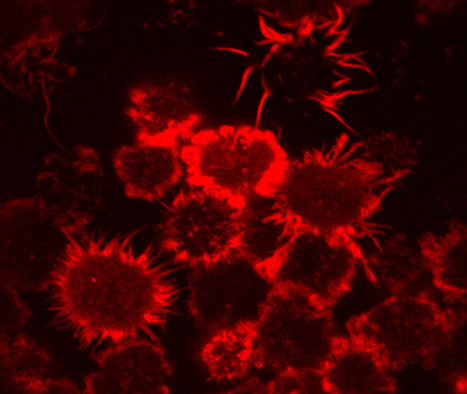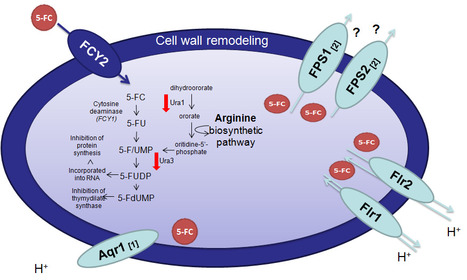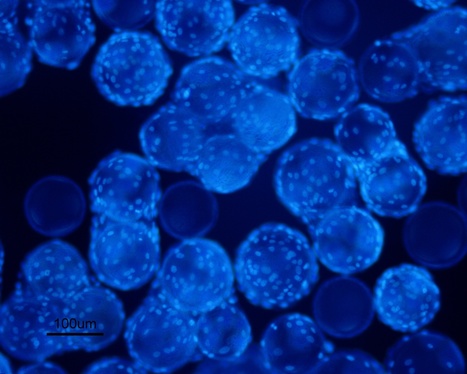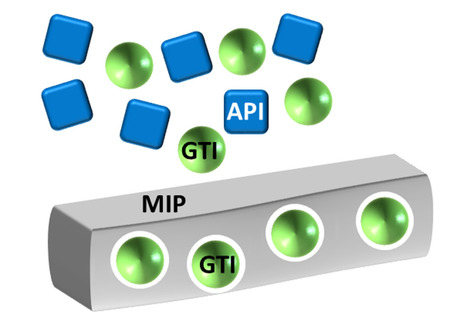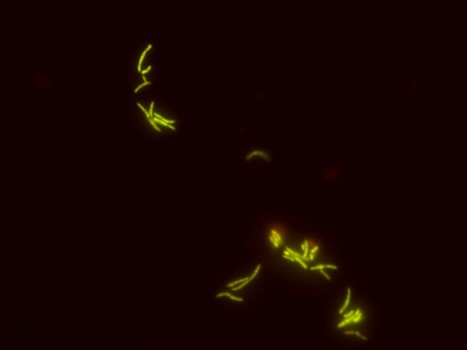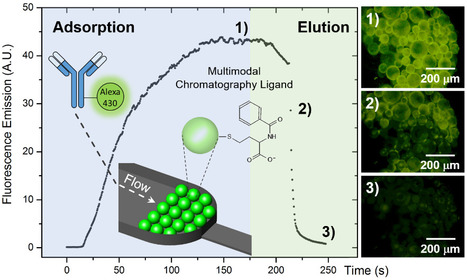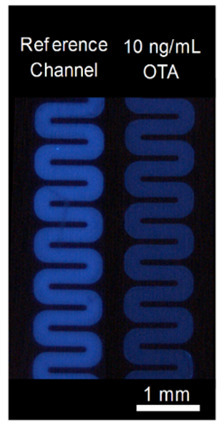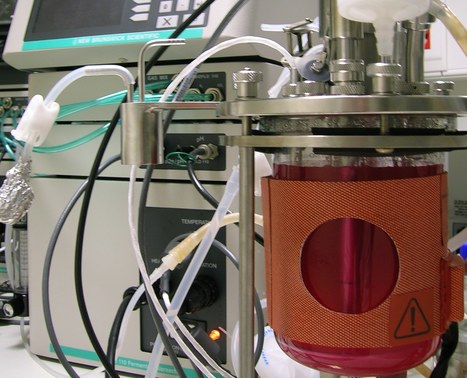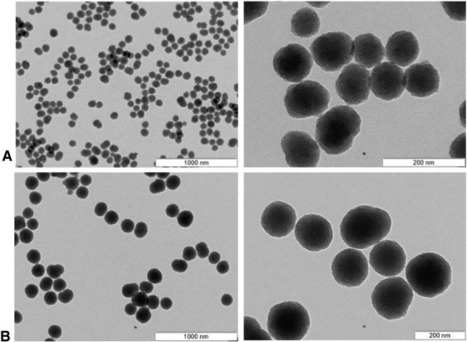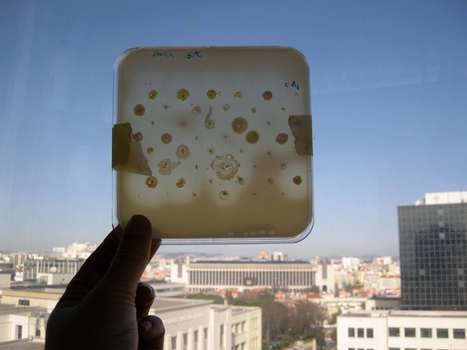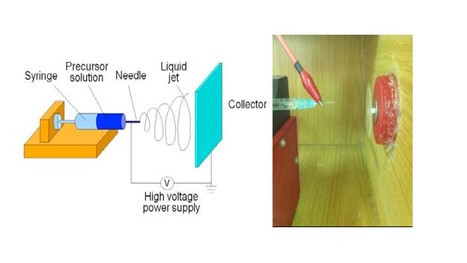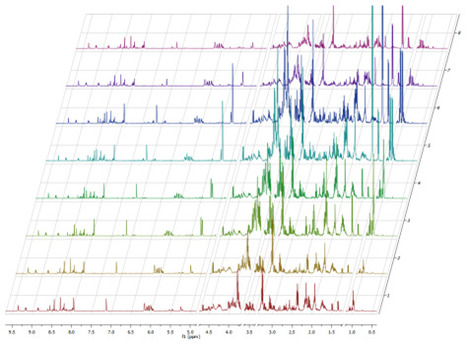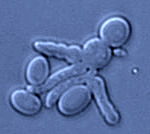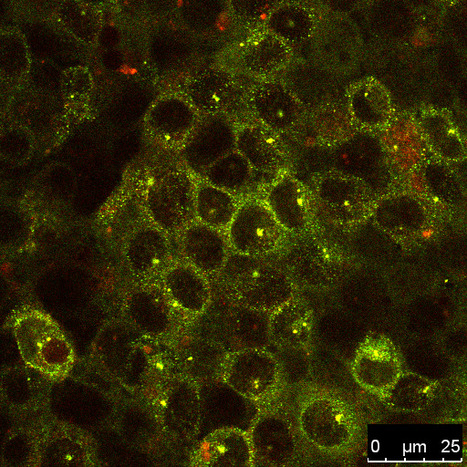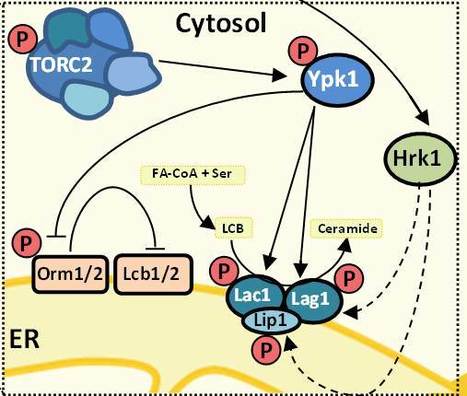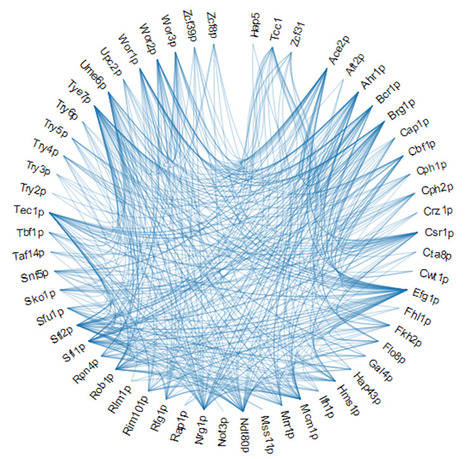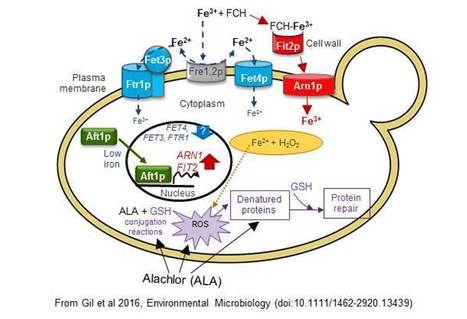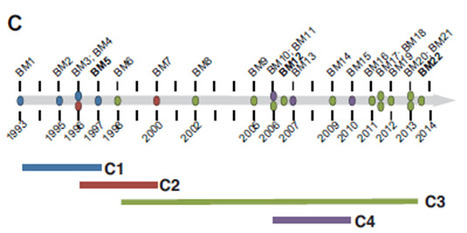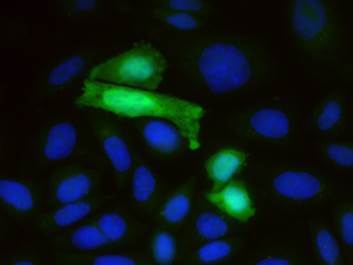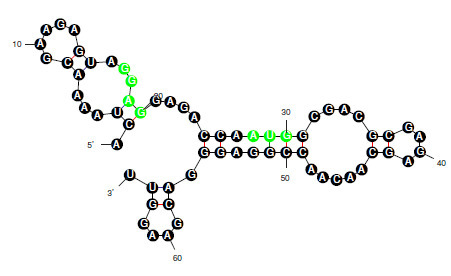Respiratory infections with Burkholderia cepacia complex (Bcc) bacteria, in general lead to a pronounced inflammatory response, followed by decline in lung function in cystic fibrosis (CF) patients. In a study recently published in Medical Microbiology and Immunology, Isabel Sá-Correia and Carla Coutinho from BSRG-iBB, in collaboration with researchers from Universidade NOVA de Lisboa, show, for the first time, that during prolonged infection, B. cenocepacia acquires the ability to survive intracellularly, inducing inflammation, while refraining DC’s maturation and stimulating non-antigen-specific T cell responses. Click on title to learn more.
Get Started for FREE
Sign up with Facebook Sign up with X
I don't have a Facebook or a X account

 Your new post is loading... Your new post is loading...
 Your new post is loading... Your new post is loading...
No comment yet.
Sign up to comment
5-Flucytosine (5-FC) is an antifungal pro-drug whose use is limited due to the acquisition of 5-FC resistance by fungal pathogens. In this study, the response of the pathogenic yeast Candida glabrata to 5-FC was evaluated at the level of the membrane proteome. New aspects of the cell response to 5-FC were observed by BSRG researchers led by Miguel Teixeira, including the increased expression of two uncharacterized drug transporters, found to catalyse the extrusion of this drug, thus contributing to increase C. glabrata resistance to 5-FC. These results, just published in Frontiers in Microbiology, are expected to contribute to maintain the usability of this drug in antifungal therapy. Click on title to learn more. Umbilical cord matrix (UCM)-derived mesenchymal stem/stromal cells (MSC) are promising therapeutic candidates for Regenerative Medicine settings. However, given the high cell doses required for clinical applications, the large-scale manufacturing of UCM MSC complying with good manufacturing practices is mandatory. In a study published in the Journal of Tissue Engineering and Regenerative Medicine, a group of researchers from BERG-iBB reported the establishment of an integrated culture platform based on a human platelet lysate supplement for the effective isolation and expansion of UCM MSC, using a xenogeneic-free microcarrier-based system featuring easy scalability. This represents an important advance in obtaining safer and clinically meaningful MSC numbers for clinical translation. Click on title to learn more. The presence of genotoxic impurities (GTIs) (e.g. reagents, intermediates, side-products) in active pharmaceutical ingredients (APIs) constitutes a high risk for human health. For this reason, regulatory authorities have established that the intake of these DNA reactive impurities should not exceed the threshold limit of 1.5 µg/day. In a recent study published in the journal Separation and Purification Technology, Teresa Esteves and Frederico Ferreira from BERG-iBB, in collaboration with researchers from Hovione and FCT-UNova, present a novel molecular imprinted polymer (MIP) that is able to efficiently remove the GTI 4-dimethylaminopyridine at concentrations as high as 1 g/L. Two case studies relevant for the pharmaceutical industry are evaluated, and a multistep configuration is proposed comprising a MIP-based step and organic solvent nanofiltration, that reduces GTI content below the limits imposed by law. Click on title to learn more. Mycolata form a group of Gram-positive bacteria, which includes Rhodococcus and Mycobacterium strains, containing long chain α-alkyl-β-hydroxy fatty acids. These cells are known for their high tolerance against antibiotics and both aromatic and aliphatic hydrocarbons. In a recent publication in the journal AMB Express, Dr. Carla CCR de Carvalho (BERG-iBB) and a team of researchers led by Dr. Hermann Heipieper (UFZ, Leipzig) have shown that R. opacus PWD4 cells respond to toxic concentrations of salt and 4-chlorophenol by changing their mycolic acid composition. The study further demonstrates the relation between mycolic acid and phospholipid synthesis and their contribution to the surface properties of these cells. Click on title to learn more. Multimodal chromatography is based on the use of synthetic ligands that provide more than one type of interaction with target analytes in a mobile phase. This technique has been showing a great potential for the purification of different biopharmaceuticals within complex biological mixtures, particularly monoclonal antibodies (mAbs). However, multimodal chromatography requires extensive optimization in a case-by-case basis to address specific purification problems. In a recent publication in the prestigious journal Analytical Chemisrty, researchers from BERG-IBB and INESC-MN led by Ana Azevedo and João Pedro Conde, developed a microfluidic platform to expedite optimization of adsorption and elution conditions of mAbs to a multimodal ligand using low amounts of reagent in a rapid and simple manner. Click on title to learn more.
From
pubs
Rejection and colonization by microbes are two problematic issues that often require the surgical removal of medical implants with increased risks for patients. In a recent publication in J. Materials Chemistry B, a team of researchers from iBB-BSRG (Nuno Mira, Diana Cunha), IST and Instituto Politécnico de Setúbal have shown that functionalization of Zn surfaces with ZnO-nanostructured 'Anastacia' flowers (NAF) results in improved biomaterials that can potentially overcome these important drawbacks and further boost the use of Zn in biomedical implants. Colonization of the NAF-coated Zn surface by Candida parapsilosis and Candida albicans, two of the more relevant microbial species colonizing medical devices, was significantly reduced on the NAF-coated Zn surface. The ZnO-derived coating is an expeditious strategy to improve the resilience of Zn-based resorbable biomaterials towards Candida spp. colonization, paving the way for the design of bioactive ZnO-derived coatings with potential for clinical applications on bone. Click on title to learn more. Photo: ZnO flowers with yeast cells. In a collaboration with the start-up company Lumisense, researchers at IBB and INESC MN have recently published an innovative biosensor to detect the mycotoxin ochratoxin A in foods and feeds, within the scope of the European project DEMOTOX (http://www.demotox.it/). By performing a chemiluminescent competitive immunoassay within 200x100 µm disposable microchannels and acquiring light with a photosensor, it was possible to obtain quantitative results in less than 5 min. This type of device shows great potential for the rapid, on-site mycotoxin screening, a highly demanded feature to assure food safety and effectively enforce EU regulations. Click on title to learn more. Mesenchymal stem/stromal cells (MSC) are being widely explored as promising candidates for cell-based therapies. In order to achieve the MSC numbers required for clinical applications, it is crucial to develop scalable culture systems that allow bioprocess control and monitoring, combined with the use of serum/xenogeneic-free culture media. In a study recently published in Biotechnology Journal, BERG-iBB researchers led by Cláudia Lobato Silva and Joaquim Cabral, in collaboration with Kamilla Swiech from University of São Paulo, Ribeirão Preto-SP, Brazil, combined gelatin-based Cultispher®S microcarriers and xeno-free culture medium for the expansion of umbilical cord matrix (UCM)-derived MSC in a stirred-tank bioreactor. The expanded cells retained their differentiation ability and immunomodulatory potential. The work represents an important step towards a GMP compliant large-scale production platform for these promising cell therapy candidates. Click on title to learn more. Alternative gene delivery vehicles to augment the efficiency of transfection both in vitro and in vivo are needed. A collaborative team of researchers from iBB-BERG (Gabriel Monteiro), Centro de Química Estrutural-IST (M.C. Gonçalves) and CESAM, Universidade de Aveiro (I. Domingues) have recently described the optimization of a method to synthesize amino-functionalized silica nanoparticles. These nanparticles were complexed with plasmid DNA to assemble specialized complexes (ORMOPLEXES), which were then characterized by physical and chemical analyses and tested in vitro and in vivo for biological activity. Click on title to read the publication in Materials Science and Engineering: C. Photo details: TEM images of ORMOPLEXES. Genomic and metagenomic techniques have promised new opportunities for the discovery of novel compounds, but isolation of microbial cells is still one of the best approaches to discover new enzymes and compounds and to develop novel processes. In a review paper dedicated to the memory of Dr. Frederik van Keulen, the iBB-BERG researcher Carla C.C.R. de Carvalho discusses screening techniques to find the best bacterial producers and approaches to improve biocatalyst performance. Fast screening techniques, strain improvement and integrated bioprocess design will certainly contribute to the production of high-value products using clean processes. Click on title to learn more. Nanofibrous materials are attracting considerable interest as their properties are fit for a wide range of applications, from tissue engineering to separation processes. In a recently published paper, Pedro Fernandes (BERG-iBB) and researchers from iMed.ULisboa and ICEMS-IST put together their expertise to assemble a home-made set-up for enzyme entrapment in polyvinyl alcohol electrospun nanofibers. Using naringinase, a debittering enzyme used for processing of fruit juice as model, the authors were able to operate a packed bed reactor filled with active nanofiber for over 200 hours with no loss of activity, a feature that highlights the potential of their approach. Click on title to learn more. In a recent paper published in Cell Cycle, a BSRG-iBB team led by Arsénio Fialho shows how the bacterial protein azurin modulates the plasma membranes’ biophysical properties of the lung adenocarcinoma A549 cancer cells. In collaboration with the group of Nuno Santos at IMM, and Fábio Fernandes (CQFM- IST), changes are detected through the nanoindentation of cells detected by Atomic Force Microscopy (AFM). AFM is a technique with increased importance in detecting and quantifying these changes, namely on elasticity and deformability which are then related to several cell processes such as adherence, signaling, invasion and proliferation. By causing such changes, azurin contributes to the sensitization of A549 cells to EGFR-targeted therapies, to which they are resistant, possibly improving the outcome of these clinical therapies in patients that may develop resistance. |
Burkholderia cepacia complex (Bcc) bacteria are exposed for several years to a stressful and changing environment during cystic fibrosis (CF) chronic lung infections. These challenging conditions lead to genetic changes of the initial infecting strain, resulting in the diversification of genotypes and phenotypes. The study recently published in Frontiers in Microbiology, coordinated by Prof. Isabel Sá-Correia and having as first author Dr. Ana S. Moreira who developed this work during her studies for the PhD degree in Biotechnology and Biosciences, provided insights into the metabolic diversification of Burkholderia cenocepacia clonal variants during infection of the CF airways, using a high resolution 1H-NMR-based metabolomic approach coupled to multivariate analysis. Results further revealed a variable content of several amino acids and the metabolites glycine-betaine and trehalose with demonstrated cellular protective functions in the four clonal isolates examined and suggested that glycolysis and glyoxylate shunt are favored in late isolates. Click on title to learn more. Candida glabrata is emerging as a human pathogen due to its unusual ability to acquire drug resistance and to tolerate human immune responses. In a study led by Miguel C Teixeira, in collaboration with other teams from the BSRG and BERG, and recently published in Cellular Microbiology, two multidrug resistance transporters were surprisingly described as determinants of C. glabrata virulence, using the infection model G. mellonella. Their mechanism of action appears to be related to their contribution to confer antimicrobial peptide resistance and to increase the proliferation of C. glabrata cells within macrophages. This knowledge is expected to contribute to the design of more effective tools against persistent candidiasis. Click on title to learn more. Burkholderia cenocepacia has emerged as a prominent opportunistic pathogen causing acute airways infections in cystic fibrosis patients. To initiate infection, B. cenocepacia must be able to colonize the respiratory epithelium, a step mediated by adhesins. In a study published in Cell Microbiology, BSRG-iBB researchers Dalila Mil-Homens and Arsénio Fialho, in collaboration with Sandra Pinto from CQFM (Lisbon) and Cecília Arraiano group from ITQB (Lisbon), demonstrated that BcaA, a trimeric autotransporter adhesin (TAA) from the epidemic strain B. cenocepacia K56-2, is a TNFR1-interacting protein able to regulate components of the tumor necrosis factor signaling pathway and ultimately leading to a significant production of the proinflammatory cytokine IL-8. Moreover, this study reinforced the multifunctional nature of BcaA and was the first to demonstrate that a protein belonging to the TAA family is involved in the induction of the inflammatory response during bacterial infections. Click on title to learn more. Acetic acid accumulation inhibits yeast growth and fermentation, impairing many yeast-based biotechnological processes, in particular lignocellulosic biorefineries. A recent study published in Biochemical Journal, performed by BSRG-iBB researchers led by Prof. Isabel Sá-Correia and started in the framework of the PhD in Biotechnology and Bioscience of Joana Guerreiro, in collaboration with researchers from Jeremy Thorner´s Lab at University of California, Berkeley, demonstrated that acetic acid tolerance requires sphingolipid biosynthesis. This process is mediated by the TORC2-dependent Ypk1 kinase, a key regulator of the sphingolipid biosynthetic pathway. It was thus proposed the manipulation of the flux into the sphingolipid biosynthetic pathway as a novel rational way to increase acetic acid tolerance of industrial yeast strains. Click on title to learn more. " "The PathoYeastract database, a repository of data on transcription regulation occurring in pathogenic yeasts responsible for the development of candidiasis in humans, has just been launched. The knowledge gathered therein by researchers from BSRG-iBB and INESC-ID was extracted from hundreds of publications. The database provides researchers in the field with computational tools that are crucial for the design of improved strategies for the diagnosis and treatment of life-threatening yeast infections. Click on title to learn more." Alachlor has been widely used as an herbicide worldwide. Concerns regarding current and legacy ecological risks, particularly in worst-case situations associated with accidental herbicide contamination, have been raised. In the EU, alachlor is in the list of priority substances in the field of water policy. A joint publication from Cristina A. Viegas and Fátima N. Gil (former PhD student) of BSRG-iBB and Gemma Bellí from the University of Lleida, Spain, in the journal Environmental Microbiology, contributes new information to better understand the potential deleterious short-term effects of alachlor in the S. cerevisiae eukaryotic model. Results point to possible links between alachlor toxicity and perturbations in metal and antioxidant homeostases, which may be relevant for environmental microbes and higher eukaryotes in situations of inadvertent high herbicide contamination. Click on title to learn more. Respiratory infections by bacteria of the Burkholderia cepacia complex (Bcc) remain an important cause of morbidity and mortality among cystic fibrosis patients. In a paper recently published in AMB Express, Silvia A. Sousa and Jorge H. Leitão from BSRG-iBB, in collaboration with researchers from Helwan University (Cairo), and medical doctors from Hospitals Sta Maria and D. Estefânia (Lisbon), studied the B. cenocepacia protein BCAL2958, a member of the OmpA-like family of proteins, showing the presence of anti-BCAL2958 antibodies in sera from cystic fibrosis patients with a clinical record of respiratory infection by Bcc, and the ability of the purified protein to in vitro stimulate neutrophils. Results strongly suggest that the protein is a potential candidate for usage in preventive therapies of infections by Bcc.
B. multivorans is the most commonly isolated Burkholderia species from chronic infections of the airways of Cystic Fibrosis (CF) patients worldwide, yet our understanding of the traits required for bacterial colonization and persistence, as well as the molecular mechanisms underlying this adaptation, are limited. In a recently published paper in mSystems, Inês N. Silva and Leonilde M. Moreira from BSRG-iBB, in collaboration with researchers from Canada, US and Portugal, put together their expertise to study how the bacteria adapts in CF patients. The genomic and functional evolution of B. multivorans was analyzed by studying sputum samples collected from a CF patient over a 20-year period. The evolutionary history of these isolates highlighted bacterial genes and pathways that were likely subject to strong selection within the host and were associated with altered phenotypes, such as biofilm production, and antimicrobial resistance. Notably, multiple lineages coexisted for years or even decades within the infection, and the period of diversification within the dominant lineage was associated with deterioration of the patient’s lung function. The work sheds new light onto Burkholderia evolution and suggests that monitoring evolutionary and molecular patterns could be used to design responsive therapies that limit population diversity and disease progression. Click on the title to learn more and access paper at Despite very good safety records, clinical trials using plasmid DNA have failed due to low transfection efficiency and brief transgene expression. One of the reasons for this failure is poor plasmid design. In a paper published in Biotechnology and Genetic Engineering Reviews, researchers from iBB-BERG led by Gabriel Monteiro review critical aspects of plasmid design including promoter, polyadenylation signal, codon optimization and/or insertion of introns or nuclear-targeting sequences. The impact of detrimental elements like CpG motifs, selection markers, origins of replication, cryptic eukaryotic signals or nuclease-susceptible regions and inverted repeats is also examined. Click on title to learn more. Photo details: CHO cells transfected with plasmid vector coding for GFP. The use of minicircles in gene therapy applications is dependent on the availability of high-producer cell systems. In order to improve the performance of minicircle production in Escherichia coli by ParA resolvase-mediated in vivo recombination, a team led by Gabriel Monteiro and Miguel Prazeres from iBB-BERG and Kristala Prather from MIT, optimized the 5′ untranslated region (5′-UTR) of parA messenger RNA (mRNA) using a predictive thermodynamic model. The optimized parA gene was then inserted in the chromosome of an E. coli strain with improved arabinose uptake. overall the results show that the improvements made in the 5′-UTR can lead to a more efficient translation and hence to faster and more efficient minicircle generation.The research was developed under the framework of the MIT-Portugal program and is a direct result of Michaela Simcikova's Ph D. thesis in Bioengineering. Click on title to read the publication in Applied Microbiology and Biotechnology. The application of PVA-based materials in bioengineering and biomedicine has been increasing, given the low cost and wide availability of PVA. Diffusion limitations may hinder the use of PVA-hydrogels in specific fields, such as biocatalysis or drug delivery. Pedro Fernandes (BERG-iBB) joined researchers from iMed.ULisboa and ICEMS-IST to develop a methodology for the production of PVA-hollow microspheres by cross-linking PVA with boronic acids. The thin-walled microspheres minimized diffusion resistances to small molecules, while presenting high biocompatibility, enzyme encapsulation efficiency and physical stability, as they endured heat sterilization. Successful use of these microspheres in biocatalysis, drug-delivery and tissue engineering is foreseen. Click on title to learn more.
Micro technology is emerging as fertile ground for innovative concepts that overcome limitations of standard culturing methods and speed up bioprocess development. In a recent publication, researchers from BERG-iBB and INESC-MN led by Pedro Fernandes (BERG-iBB) presented a microfluidic platform enabling the continuous production of biomolecules by trapping non-adherent cells. Using invertase production by Saccharomyces cerevisiae cells as model system, the authors optimized microreactor design and operational conditions so that productivity was consistently higher than that in macroscale systems, throughout 32 hours of continuous operation. The work demonstrates the feasibility of microfluidic platforms as alternatives to conventional production methods. Click on title to learn more. |


